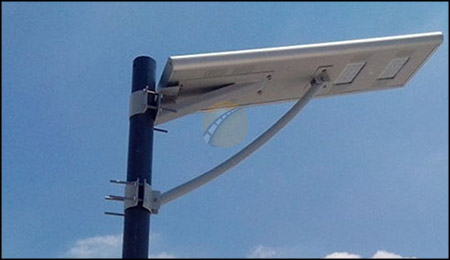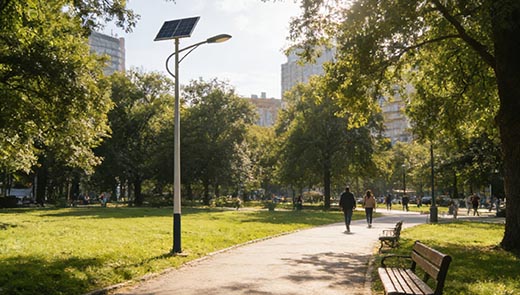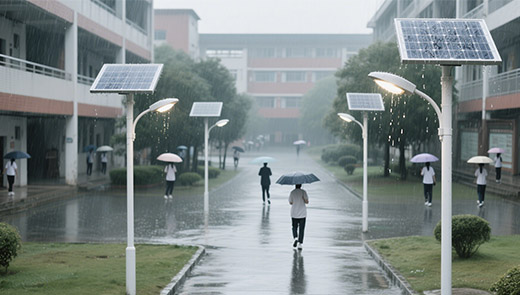Five Traps To Avoid Before Buying Led Solar Street Light
In the process of upgrading outdoor lighting, LED solar street lights have become the first choice for municipalities, neighborhoods, parks and other scenarios by virtue of their energy-saving, environmentally friendly and no need to lay wires advantages. However, most purchasers are prone to fall into the “only look at the price, ignoring the core performance” of the misunderstanding, resulting in the purchase of the street light has insufficient brightness, frequent failures and other issues, which not only affects the use of the experience, but also increase the cost of late maintenance. This article will combine the technical principles and practical application scenarios, dismantle the purchase of LED solar street lights are most likely to step on the 5 traps, to help you accurately avoid the risk of selecting a more cost-effective products.
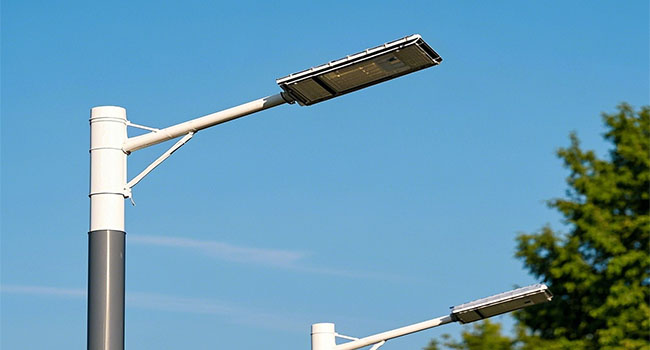
Neglecting the importance of battery capacity
Battery as the “energy storage core” of LED solar street light, directly determines whether the street light can continue to emit light stably at night. Many purchasers only focus on the physical size of the battery, but ignore the capacity and the actual needs of the match, ultimately leading to street lamps can not meet the requirements of lighting hours.
The scientific calculation method of solar street light battery capacity
Before purchasing, we need to calculate the required battery capacity according to the actual scenario, with core reference to three key elements: local sunshine hours, street light operation hours and street light power. The average daily effective sunshine time in different areas varies greatly, the shorter the sunshine time, the larger the required battery capacity.
The running hours of solar street lights should be clear about the specific lighting hours, and it is recommended to reserve 1-2 hours of redundancy on the basis of the actual demand, so as to avoid insufficient power due to weather changes. The power of street light directly affects the power consumption per unit of time, for example, the hourly power consumption of 30W street light is twice as much as that of 15W street light, which needs to be matched with larger capacity battery. Specific calculations can refer to the formula: Battery capacity (Ah) = (street light power × operating hours) ÷ (battery voltage × sunshine hours × conversion efficiency), of which the conversion efficiency is usually taken as 0.7-0.8 (taking charging losses into account).
Not considering the quality of the solar panel
Typical problems of low-quality solar panels
The most prominent problem of low-quality solar panels is the low conversion efficiency. The conversion efficiency of high-quality products is usually in the range of 17%-22%, while that of low-quality products may only be 10%-15%, which is unable to provide sufficient power for the batteries even on sunny days, resulting in insufficient brightness of street lights at night. Even on sunny days, the battery is not sufficiently charged, resulting in insufficient brightness of street lights at night.
Secondly, the aging speed is fast, this kind of solar panel mostly adopts poor quality silicon and coating, after 1-2 years of use, the coating will fall off, silicon oxidation will occur, the conversion efficiency will further decline by more than 30%, and basically lose the ability to generate electricity.
In addition, the weather resistance of low-quality solar panels is extremely poor, in torrential rain, high temperature, strong winds and other inclement weather, the frame is prone to rust, the glass is easy to crack, and even internal circuit short-circuiting, which will directly lead to the paralysis of the entire street light system. What's more, the low-quality solar panels produced by small workshops have no quality certification, so they can't be repaired or replaced after the problem occurs, and they can only be purchased again, which increases the cost.
Judging the quality of solar panels
Judging the quality of solar panels should start from four core dimensions: conversion efficiency, material technology, certification and warranty period. Conversion efficiency need to check the product parameter table, the labeled value should be between 17%-22%, not labeled or less than 15% of the products need to be directly excluded. In terms of material technology, high-quality solar panels use tempered glass surface and corrosion-resistant aluminum frame (to adapt to the humid outdoor environment), while low-quality products use ordinary glass and plastic frame, which is easy to be damaged.
Certification is a key guarantee, quality products need to have international certification, these certifications will be the conversion efficiency of the product, weather resistance, safety, strict testing, do not buy products without any certification documents. Warranty period can also reflect the quality of the product, high-quality solar panels usually provide 5 years of warranty service, and commitment to 25 years of power attenuation of no more than 20%, while low-quality products more than no warranty or only provide a 1-year warranty, the subsequent risk is very high.
The heat dissipation design of solar street lights is significant
Serious consequences of poor heat dissipation of solar street lights
The most direct impact of poor heat dissipation is the rapid decline in the brightness of LED street light beads, the brightness of the newly installed street light may drop by 20% within 1 month, and the brightness can only reach 50% of the initial value after 6 months of use. After 6 months of use, the brightness can only reach 50% of the initial value, which can not meet the brightness requirements of road lighting. Secondly, the lamp beads are frequently burnt out. High temperature will lead to melting of the lamp bead soldering points and short circuit of the internal circuit, requiring frequent replacement of the lamp head, which not only increases the maintenance cost but also affects the normal lighting of the road section.
In addition, some low-quality street lamps due to poor heat dissipation, the lamp body shell temperature can reach more than 70 ℃, in the summer high temperature environment, may trigger the melting of plastic parts, line aging, and even the existence of fire hazards. At the same time, poor heat dissipation will also affect the overall stability of the street light, resulting in the failure of the controller, sensors and other components, the problem of “no charging during the day, no light at night”.
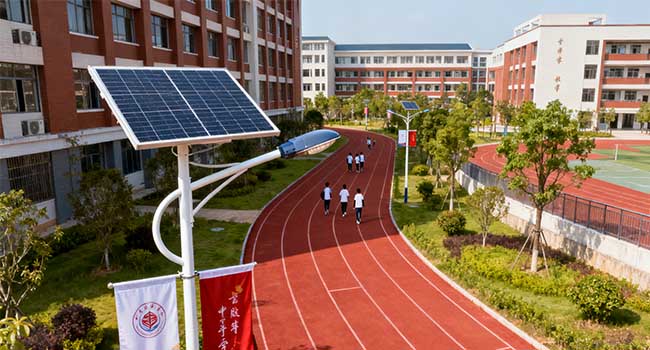
Core features of quality heat dissipation design
Identifying quality led solar street light heat dissipation design needs to focus on three key points: heat dissipation material, heat dissipation structure and actual heat dissipation effect. Heat dissipation material, high-quality street lamps using aluminum alloy heat sink, aluminum alloy thermal conductivity is more than 10 times that of plastic, can quickly conduct the heat generated by the LED lamp beads, while low-quality street lamps use plastic or iron heat dissipation, heat is easy to accumulate.
Heat dissipation structure, effective design more “fin” structure, through the multi-layer raised fins to increase the heat dissipation area, accelerate the exchange of heat and air, part of the high-end products will also be in the heat sink to add thermal conductivity of silicone, to further enhance the thermal efficiency, and no cooling fins, only rely on the lamp body shell heat dissipation products, the cooling effect is usually Poor.
The actual heat dissipation effect can be judged by a simple test, the street lamp will be lit for 2 hours, touch the lamp body shell, if only feel “warm” (temperature ≤ 50 ℃), that is, good heat dissipation, if the feeling of “hot” (temperature ≥ 60 ℃), it indicates that the thermal design Problems exist, not recommended to buy.
The more lamp beads, the more brighter of the street lights?
Many merchants will deliberately emphasize “100 lamp beads” “200 lamp beads” and other selling points to make consumers mistakenly believe that the LED solar street lights are the best choice. " and other selling points, so that consumers mistakenly think that the greater the number of lamp beads, the higher the brightness of the street lights. But in fact, the number of lamp beads and brightness is not directly related to this publicity is essentially a business to take advantage of the consumer cognitive misunderstanding of the design of the trap.
Number of lamp beads ≠ brightness
The actual brightness of a street light is determined by “total power” and “lamp bead efficiency”, not the number of lamp beads. For example, the brightness of 50 high quality 0.5W lamp beads (total power 25W) is much higher than 100 low quality 0.2W lamp beads (total power 20W) because the total power is higher and the luminous efficacy (lumens per watt) of high quality lamp beads is better.
Secondly, too many lamp beads will increase the resistance of the circuit, resulting in more than 15% of the power in the transmission process is wasted, but shorten the battery power supply time, so that the street lamp lights less time. In addition, in order to make up the number of lamp beads, some merchants will use low brightness, low life of poor quality lamp beads, such lamp beads are not only poor luminous efficiency, but also prone to aging failure in a short period of time, resulting in a rapid decline in the brightness of street lights.
The key indicators for correctly determining the brightness of street lights
When purchasing, you don't need to pay attention to the number of lamp beads, but only need to focus on two core indicators: actual power and lumen value (lm). Actual power refers to the rated power of the street light, which should be clearly labeled in the parameter table, such as 30W, 50W, etc. The higher the power, the higher the brightness under the same luminous efficacy, and it is recommended to choose the products with more than 30W for roadway lighting, and the products with 15-20W for yard, trail and other scenarios.
Pay attention to the overall configuration of led solar street lights
Improper configuration of solar street lights will cause a variety of problems, first of all, the controller does not match the battery, solar panels, high-quality batteries with poor quality controller, there will be “overcharge” or “overdischarge” problem. “ or ”overcharge" problem, overcharge will lead to battery bulging, life shortening, overcharge will make the battery loss of power, can not be normal power supply, serious 1 year can lead to battery scrap.
Secondly, the light pole is not enough load-bearing, the total weight of solar panels and batteries is about 10-20kg, if the pole is made of thin steel plate or low-quality steel, it is easy to tilt and collapse in strong winds, which is a potential safety hazard. Poor waterproof performance is also a common problem, the battery box, light head wiring does not meet the IP65 and above protection level, rainy days easy to enter the water short-circuit, resulting in damage to the controller, battery.
Requirements for choosing quality system configuration
Three principles should be followed when choosing quality system configuration: prioritizing “one-stop” brands, checking the protection level, and paying attention to structural stability. Priority is given to brands that can produce all components independently. Such brands will conduct compatibility tests on components to ensure that the parameters of solar panels, batteries, controllers and other components are matched to avoid incompatibility problems.
Check the protection level of each component. Battery boxes and light heads should be IP65 rated, and controllers should be IP67 rated, as products with insufficient protection level cannot adapt to the harsh outdoor environment. In terms of structural stability, the pole should be made of Q235 steel with a thickness of not less than 3mm to ensure that it can withstand the weight of the solar panels and batteries, and the wind resistance of the pole should be ≥12 to adapt to the wind environment in different regions, and the battery bracket should be reinforced to prevent it from shaking and falling off during long-term use.
Selection of LED solar street lights need to jump out of the “only look at the price, only look at the surface parameters” of the inertia of thinking, from the battery capacity matching, solar panel quality, heat dissipation design, brightness of the core indicators to the overall system configuration, one by one to verify the key details. The only way to take into account the performance, quality and scene needs, in order to avoid procurement traps, selected both to meet the current lighting needs, but also reduce long-term maintenance costs of cost-effective products, so that outdoor lighting to truly achieve stability, high efficiency and energy saving.

